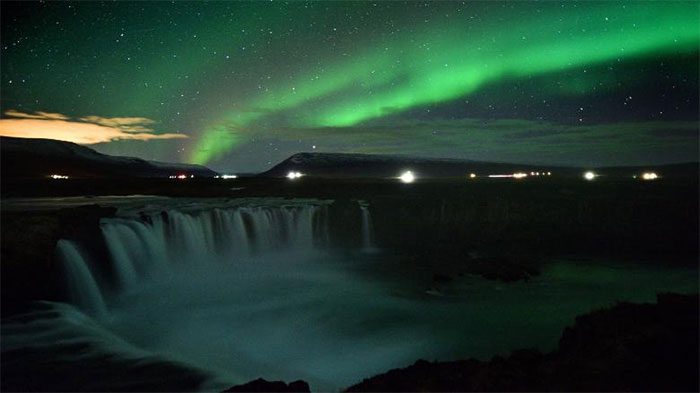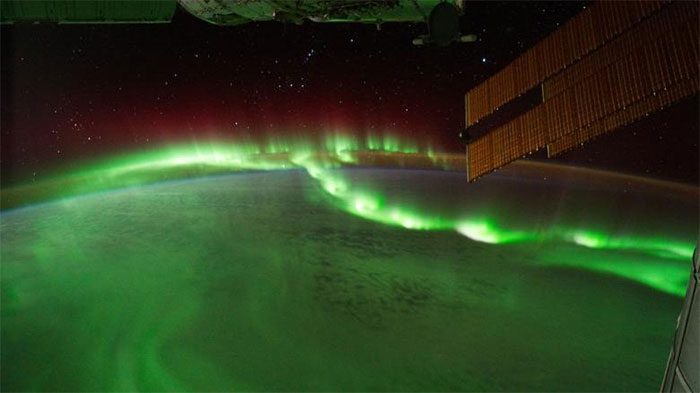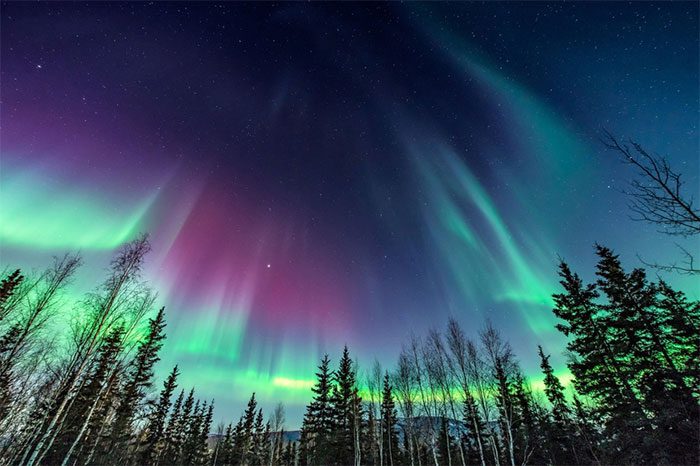After centuries of speculation, scientists have finally proven the mechanism behind the auroras in the northern hemisphere.
The aurora borealis, or northern lights, is a colorful light display that appears in the northern hemisphere. The aurora is described as a magnificent light show on Earth. This phenomenon only occurs in high latitude areas, leaving scientists amazed for centuries.
Speculations about the mysterious origins of the aurora have existed for a long time. However, it is only now that unfounded assumptions have been clearly proven.
The Mystery Revealed
According to a new study published in the journal Nature, a group of physicists from the University of Iowa has finally demonstrated that the aurora “is created by strong electromagnetic waves during geomagnetic storms.”

The northern lights appear over a waterfall in Iceland. (Photo: Getty Images).
The research indicates that these phenomena are known as Alfvén waves, which propel electrons toward Earth, causing particles to produce the light stream that scientists refer to as the aurora.
“Measurements reveal a small number of electrons undergoing ‘resonant acceleration’ by the electric field of Alfvén waves, similar to how a surfer catches a wave and continues to accelerate while riding it,” said Associate Professor Greg Howes from the Department of Physics and Astronomy at the University of Iowa, who is also a co-author of the study.
The idea that electrons “surf” on electromagnetic fields was first introduced in 1946 by Russian physicist Lev Landau. This theory is known as Landau damping. After more than 70 years, Landau damping has been validated.
Recreating the Aurora
After decades of research, scientists have understood how the aurora is created, but only now have they been able to recreate these colorful light bands in the laboratory. For the first time, artificial auroras have been replicated in a lab using a large plasma physics device (LPD) at the Basic Plasma Science Facility (BaPSF) at UCLA.

The aurora observed from the International Space Station. (Photo: NASA).
According to CNN, scientists used a 20-meter-long room to recreate Earth’s magnetic field using strong magnetic coils on UCLA’s LPD device. Inside the room, they created a plasma environment similar to what exists in space near Earth.
“By using specially designed antennas, we launch Alfvén waves into the machine, similar to shaking a garden hose up and down and observing the waves move along the hose,” Howes said.
As they began to experience electrons “surfing” along the waves, they used other specialized instruments to assess how the electrons gain energy from the waves.
“Although the experiment did not recreate the colorful light bands seen in the sky, our laboratory measurements matched predictions from computer simulations and mathematical calculations, demonstrating that electrons surfing on Alfvén waves can accelerate up to 72 million km/h and create the aurora,” Howes noted.
Craig Kletzing, a co-author of the study, added that these experiments allow them to make precise measurements to validate space observations and hypotheses that explain how the aurora is generated.

The aurora captured in Alaska. (Photo: Getty Images).
Many space scientists are also excited about this new development.
“I am very excited! There are very few lab experiments that can validate hypotheses and models related to the space environment. Because space is so vast that it cannot be simulated in a lab,” said Patrick Koehn, a scientist from NASA’s Helicopter Physics Department.
According to Koehn, understanding the acceleration mechanisms of electrons that create the aurora will be beneficial for many future studies.
A Long Road Ahead
Currently, the hypothesis on how auroras are generated has been proven, but there is still a long way to go to predict the strength of upcoming storms.
“Predicting the strength of a specific geomagnetic storm based on observations of the Sun and measurements from spacecraft between Earth and the Sun remains a challenging problem without a solution,” Howes stated.
Howes explained that they have established the link of electrons surfing on Alfvén waves about 16,000 km above the Earth’s surface. Now, they must learn how to predict the strength of those Alfvén waves using space observatories.





















































